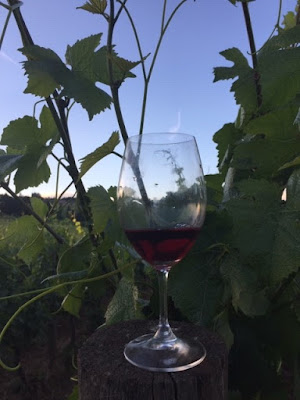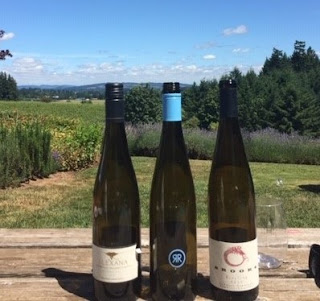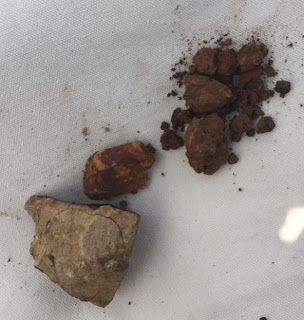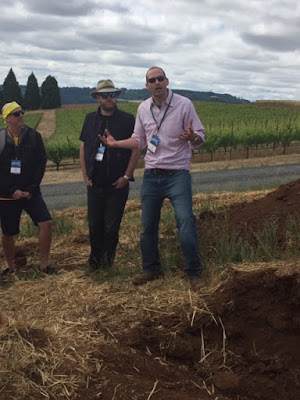Being invited to the Oregon Pinot Camp is like being handed a golden ticket. Just imagine, a camp for adults in the wine country of Oregon, dedicated to the wines, wineries, and wine makers of this beautiful state. What could be more fun?
When I got the good news that I got into camp this year, I was thrilled, as colleagues who have attended this camp in previous years have regaled me with stories from this four-day deep dive into Willamette Valley and its wines, including the festive last-day salmon bake, myriad winery and vineyard tours and, of course, wine sampling.
Oregon Pinot Camp, or OPC, occurred in mid-June this year, and hosted 270+ wine industry retailers, distributors, sommeliers, and wine/beverage directors from the around the world. OPC lived up to my expectations and surpassed it in many ways. I want to thank The Wine House (my employer) co-owner and domestic wine buyer Glen Knight for aggressively pushing for my acceptance to camp, and also Elk Cove Vineyards for sponsoring me. I’ll be forever grateful, and better informed about Oregon wines.
Riesling Rising
Oregon Pinot Camp is not just about Pinot Noir; it’s also about Riesling, Chardonnay, Pinot Gris, and Gamay, as well as rosé and bubbles. There is much to explore.
At the “Riesling Revival” gathering, held before camp opening at the gorgeous Five Mountains Vineyard home of Elk Cove Vineyards winemaker Adam Campbell (son of founders Pat and Joe Campbell) a half dozen or so Riesling producers gathered for a tasting, paired with excellent Szechuan food, for a pool-side relaxed gathering. Producers pouring their Rieslings included Alexana, Brooks Winery, Elk Cove Vineyards, Hyland Estates, Ponzi Vineyards, Trisaetum, Union Wine Co., and Van Duzer Vineyards.
I chose this event, rather than the one that focused on Chardonnay, because I had a gut feeling that the Rieslings of Oregon were going to shine brighter, and I wanted to try them all at one sitting.
And I was right. Riesling is the white wine of Oregon, in my opinion, with beautiful acidity, nice minerality, complexity, and an ability to be drunk as an aperitif or paired with all kinds of food.

And there’s something about the winemakers of Oregon. They are extremely passionate about wines from the Willamette Valley, from the various AVAs and sub-AVAs, as well as about the Riesling grape. And let’s face it, Riesling is a hot grape in the sommelier world these days. So, being with winemarkers like Florent Merlier of Van Duzer, Ken Campbell of Elk Cove, Bryan Weil of Alexana, and Luisa Ponzi of Ponzi, as they poured their wines and discussed Riesling’s heavenly mission was literally like being at a Revival. And the antics of the day lived up to the event’s name, as a “high priest” blessed the event, the wines, and “baptized” several winemakers as they drank from the holy chalice (see photo, left) of mixed Rieslings from the various producers.
Antics aside, I firmly believe that the Rieslings of Oregon are world-class and hope that it will become easier to sell them to customers in the future. Riesling is a hard sell, and consumer education is still needed to get the word out about this noble grape in general, and Oregon Riesling in particular.
I don’t mean to dismiss the Chardonnays of Oregon. I did find one in particular that was splendid, from Robert Brittan of Brittan Vineyards. This Burgundian-style Chardonnay was light and refreshing, with a complexity and lingering finish that were extremely pleasing — and I rarely indulge in domestic Chardonnay, truth be told.
Pinot, Powered by Terroir
There’s no doubt about the fact that Pinot Noir is king in Oregon. It’s the grape that most Oregon winemakers hang their hat on. And for good reason.
The Willamette Valley is an extremely diverse region in terms of soils, elevations, and micro-climates, and this results in a variety of Pinot styles, from rich and luxuriant, fruit-forward versions to light-bodied and “feminine” Burgundian versions. The terroir has everything to do with the wine style.
For the most part, Oregon Pinots are grown on the South and Southeast-facing hills, at between 200 and up to 900 feet elevation on volcanic, marine, or windblown loess soils. Volcanic soils produce Pinots that are lush, perfumed and bright red. Pinots from marine sediment tend to be bold, chewy, spicy, with black fruit flavors. Loess soil Pinots offer blueberry, plum, chocolate cherry and spice.
It’s not unusual to have different soils within feet of each other in vineyards in Willamette Valley. For example, Steve Doerner, winemaker at Cristom Vineyards in Eiola-Amity Hills, showed OPC campers two sites just 100 feet from each other that had completely different soils, one with rocky volcanic soil and one with richer, more fertile Jory. This is important in vineyard management as the various soils need to be worked differently. Volcanic soil, for instance, is best dry farmed, because when it gets wet it is very slick, for both tractors and humans. Sandy soils not so much.
Another aspect of the terroir is the air, and a great example of how it affects vineyards is the Van Duzer corridor, which guides cool ocean breezes into the valley, particularly effective in the Eola-Amity Hills AVA. Pinot Noir grapes like coolness, and the breezes also cut down disease pressure.
Each producer of Oregon Pinot Noir has their style: For the lighter, more feminine styles, there’s Chehalem and Soter, two of my favorites. For bigger, bolder Pinots, there’s Ken Wright Cellars, which produces a Pinot from 16 different vineyards throughout the Willamette Valley, showcasing the terroir of each. For a more earthy style, there’s Antica Terra. There are dozens more great choices among Oregon Pinots. Check them out at the Oregon Winegrower’s Association Web site.
|
|
Until next time,
Cheers!





